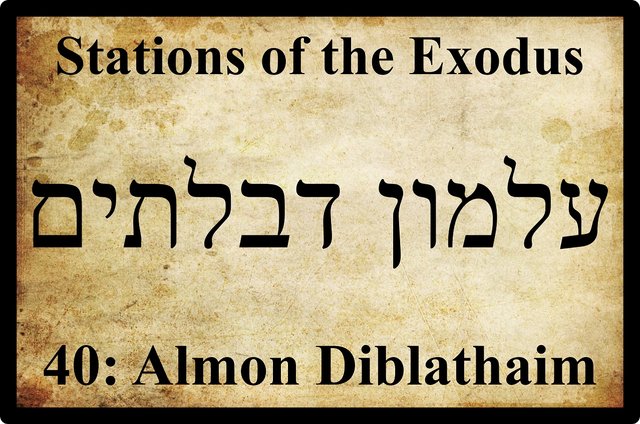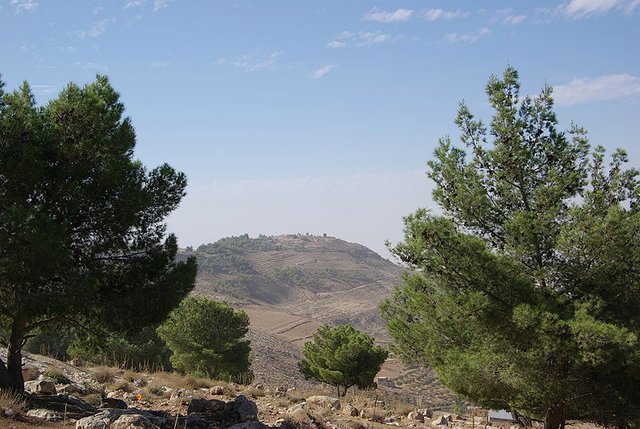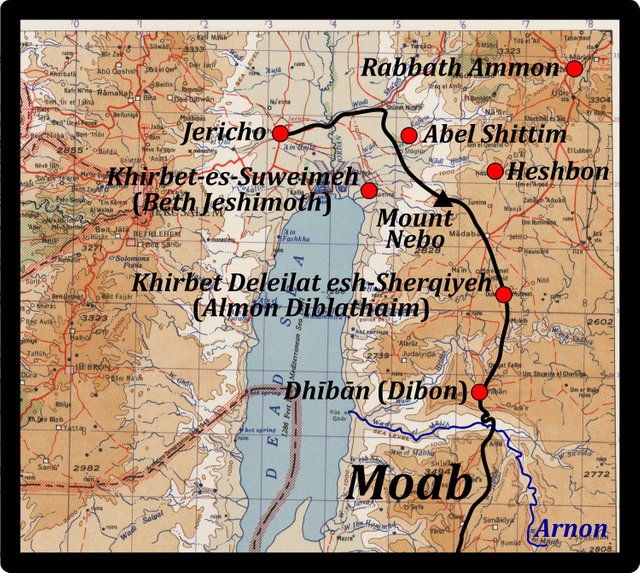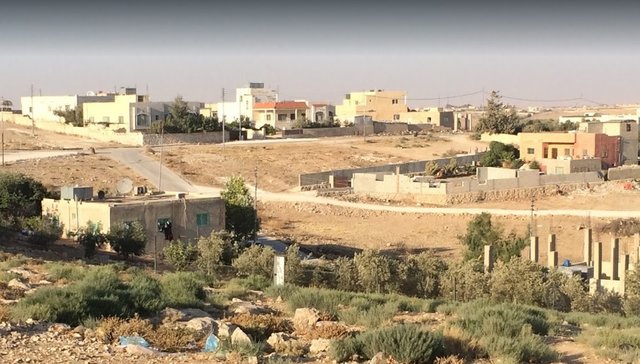
In the catalogue of Stations of the Exodus in Chapter 33 of the Book of Numbers, the fortieth station is a place called Almondiblathaim:
And they removed from Dibongad, and encamped in Almondiblathaim. And they removed from Almondiblathaim, and pitched in the mountains of Abarim, before Nebo. And they departed from the mountains of Abarim, and pitched in the plains of Moab by Jordan near Jericho. And they pitched by Jordan, from Bethjesimoth even unto Abelshittim in the plains of Moab. (Numbers 33:46-49)
The main Exodus narrative in Numbers 21, however, does not mention any such place as Almondiblathaim:
And they journeyed from Oboth, and pitched at Ijeabarim, in the wilderness which is before Moab, toward the sunrising. From thence they removed, and pitched in the valley of Zared. From thence they removed, and pitched on the other side of Arnon, which is in the wilderness that cometh out of the coasts of the Amorites: for Arnon is the border of Moab, between Moab and the Amorites. Wherefore it is said in the book of the wars of the Lord, What he did in the Red sea, and in the brooks of Arnon, And at the stream of the brooks that goeth down to the dwelling of Ar, and lieth upon the border of Moab. And from thence they went to Beer: that is the well whereof the Lord spake unto Moses, Gather the people together, and I will give them water. Then Israel sang this song, Spring up, O well; sing ye unto it: The princes digged the well, the nobles of the people digged it, by the direction of the lawgiver, with their staves. And from the wilderness they went to Mattanah: And from Mattanah to Nahaliel: and from Nahaliel to Bamoth: And from Bamoth in the valley, that is in the country of Moab, to the top of Pisgah, which looketh toward Jeshimon. (Numbers 21:11-20)
As we have seen, there is some overlap between these two accounts:
Pisgah and Nebo are generally considered to refer to one and the same mountain, an equation that is justified by a passage in Deuteronomy: And Moses went up from the plains of Moab unto the mountain of Nebo, to the top of Pisgah, that is over against Jericho. (Deuteronomy 34:1)
Bethjesimoth and Jeshimon may refer to one and the same place—possibly Khirbet es-Suweimeh, which is close to the northeastern shore of the Dead Sea.

The identities and locations of Beer, Mattanah, Nahaliel and Bamoth remain unknown. Almon Diblathaim, however, is generally identified with a place with a similar name:
The exact names Dibon-gad, Almon-diblathaim, and Abel-shittim are also unique to this passage, but they clearly correspond to Dibon, Beth-diblathaim, and Shittim well known in other texts. It seems safe to associate Punon with Khirbet el-Feinan in Wādī el-Feinan and Dibon(-gad) with Dhībān immediately north of Wādī Mūjib. (Miller 581)
Beth Diblathaim is mentioned in Jeremiah 48, where it appears in a list of places in Moab:
Moab is confounded; for it is broken down: howl and cry; tell ye it in Arnon, that Moab is spoiled, And judgment is come upon the plain country; upon Holon, and upon Jahazah, and upon Mephaath, And upon Dibon, and upon Nebo, and upon Bethdiblathaim ... (Jeremiah 48:20-22)
As we have seen, the River Arnon formed the northern boundary of Moab at the time of the Exodus, separating it from the Kingdom of Sihon the Amorite. But by the time of Jeremiah—6th century in the conventional chronology, 4th century in the Short Chronology—the territory of Moab extended much farther north.
Beth-diblathaim—The name signifies “the house of the double cake of figs,” and was, probably, applied to one of the more fertile districts of the Moabite country. In Numbers 33:46-47, the name Almon-diblathaim appears as one of the stations of the Israelites between Dibon and “the mountains of Abarim before Nebo,” and the conjunction of the names implies its identity with the place here mentioned. (Ellicott 5:153)
Unfortunately, we don’t know where Beth Diblathaim was, so it is not much help in locating Almon Diblathaim.
Almon-diblathaim. Probably the same as the Beth-diblathaim mentioned in Jeremiah 48:22 as a Moabitish town contiguous to Dibon, Nebo, and Kiriathaim. The name, which signifies “hiding-place of the two circles” or “cakes,” was doubtless due either to some local legend, or more probably to the fanciful interpretation of some peculiar feature in the landscape. (Spence & Exell 428)
Almon-diblathaim is Strong’s 5963:

ALMON DIBLATHAIM ... The name was probably given because the location was like two lumps of pressed figs. In both occurrences the word has the accusative ending of direction, and should properly be read: “Almon toward Diblathaim.” (Orr 100)
Does this mean that the actual name of the place was Almon, meaning hidden or concealed, and it lay on the road that led toward Beth Diblathaim (the House of the Two Fig Cakes), wherever that was? Could Beth Diblathaim be another name for Dhībān (Dibon Gad)?
The Biblical archaeologist and geographer Yohanan Aharoni has suggested a possible location for Almon Diblathaim:
ALMON-DIBLATHAIM (Heb. עַלְמוֹן דִבְלָתַיִם), city in the northern Moabite plain (the Mishor) between Dibon-Gad and the mountains of Abarim (Num. 33:46–47), along the route followed by the Israelites on their way to the plains of Moab (Arvot Mo’av). Khirbet Deleilat esh-Sherqiyeh, a site containing Iron Age i–ii pottery, located about 10½ mi. (17 km.) north-northeast of Dibon (Dhiban), has been suggested for its identification. (Skolnik & Berenbaum 683)
Khirbet Deleilat esh-Sherqiyeh is approximately half-way between Dhībān and Mount Nebo, close to the modern town of Dulaylat al Hama’idah.

From Dhībān to Mount Nebo
Mount Nebo lies about 30 km north of Dhībān. If the Israelites were covering 24-32 km per day (Hoffmeier 120), they could have completed this leg of their Exodus in a single day without the need for any overnight encampment—ie station—along the way. Does this mean that there never was a genuine station called Almon or Almon Diblathaim?
Conclusion
Almon Diblathaim of Numbers 33 probably refers to an unidentified place somewhere between Dhībān and Mount Nebo. It may have been located at Khirbet Deleilat esh-Sherqiyeh, but it remains uncertain whether it was a genuine Station of the Exodus.

To be continued ...
References
- Fred Skolnik, Michael Berenbaum (editors), Encyclopaedia Judaica, Second Edition, Volume 1, Thomson Gale, Farmington Mills, MI (2006)
- Charles John Ellicott (editor), An Old Testament Commentary for English Readers, Volume 5, Cassell & Company, Limited, London (1884)
- James K Hoffmeier, Ancient Israel in Sinai: The Evidence for the Authenticity of the Wilderness Tradition, Oxford University Press, Oxford (2005)
- John McClintock, James Strong, Cyclopaedia of Biblical, Theological, and Ecclesiastical Literature, Volume 2, Harper & Brothers, New York (1868)
- J Maxwell Miller, The Israelite Journey through (Around) Moab and Moabite Toponymy, Journal of Biblical Literature, Volume 108, Number 4, pp 577-595, The Society of Biblical Literature, Atlanta, GA (1989)
- James Orr (General Editor), The International Standard Bible Encyclopedia, Volume 1, The Howard-Severance Company, Chicago (1915)
- Henry Donald Maurice Spence, Joseph S Exell (editors), The Pulpit Commentary, Volume 2, Part 2, Numbers, Funk & Wagnalls Company, New York (189?)
- James Strong, Hebrew and Chaldee Dictionary, in The Exhaustive Concordance of the Bible, Eaton & Mains, New York (1890)
Image Credits
- Mount Nebo: © Berthold Werner, Creative Commons License
- Moab and the Approaches to Jericho: University of Texas Libraries, Perry-Castañeda Library Map Collection, Jerusalem, D Survey, Great Britain War Office and Air Ministry (1960), Public Domain
- Dulaylat al Hama’idah: © ns sj (photographer), Fair Use
